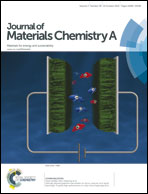Synthesis and electrochemical properties of Li3V2(P1−xBxO4)3/C cathode materials
Abstract
B-doped compounds Li3V2(P1−xBxO4)3/C (x = 0, 0.01, 0.03, and 0.07) are prepared by a sol–gel method. The crystal structure, morphology and electrochemical properties of B-doped Li3V2(PO4)3 are investigated. X-ray diffraction (XRD) analysis indicates that a B atom enters the crystal structure of Li3V2(PO4)3 but does not change the monoclinic structure. Cycle stability and rate performance measurements reveal that moderate B doping improves the electrochemical properties of Li3V2(PO4)3. Among all the B-doped samples, Li3V2(P0.97B0.03O4)3/C shows the largest initial discharge capacity, best cycle stability and rate performances. In the potential range of 3.0–4.3 V, Li3V2(P0.97B0.03O4)3/C delivers a discharge capacity of 127.5 mA h g−1 at 0.2C rate, while at 20C the discharge capacity remains above 100 mA h g−1. After 100 cycles, the discharge capacity retention is 98%. Moreover, electrochemical impedance spectroscopy (EIS) and cyclic voltammetry (CV) curves indicate that B doping not only decreases the charge transfer resistance but also increases the Li-ion diffusion rate. The excellent electrochemical performance of Li3V2(P0.97B0.03O4)3/C can be attributed to its larger Li ion diffusion, smaller particle size, and higher structural stability and electronic conductivity induced by B doping.


 Please wait while we load your content...
Please wait while we load your content...